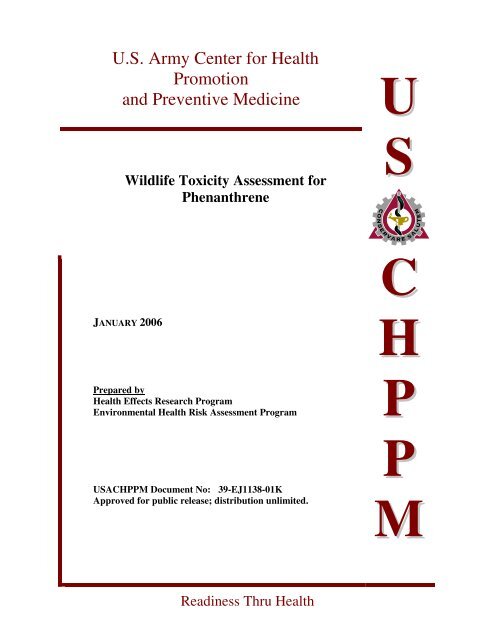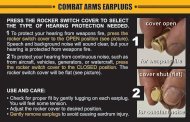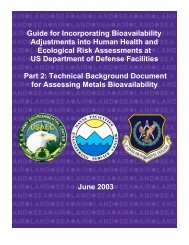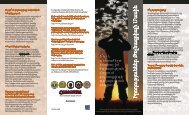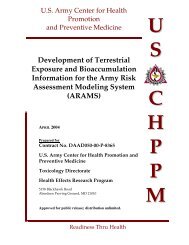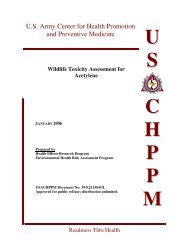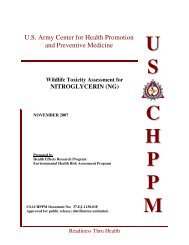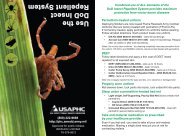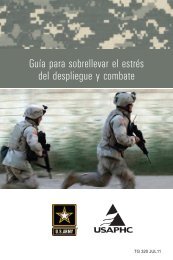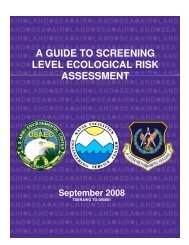Phenanthrene - U.S. Army Public Health Command
Phenanthrene - U.S. Army Public Health Command
Phenanthrene - U.S. Army Public Health Command
Create successful ePaper yourself
Turn your PDF publications into a flip-book with our unique Google optimized e-Paper software.
U.S. <strong>Army</strong> Center for <strong>Health</strong>Promotionand Preventive MedicineUWildlife Toxicity Assessment for<strong>Phenanthrene</strong>SCJANUARY 2006HPrepared by<strong>Health</strong> Effects Research ProgramEnvironmental <strong>Health</strong> Risk Assessment ProgramPPUSACHPPM Document No: 39-EJ1138-01KApproved for public release; distribution unlimited.MReadiness Thru <strong>Health</strong>
Wildlife Toxicity Assessment for<strong>Phenanthrene</strong>FINAL REPORTJANUARY 2006Prepared by<strong>Health</strong> Effects Research ProgramEnvironmental Risk Assessment ProgramUSACHPPM Document No: 39-EJ1138-01KApproved for <strong>Public</strong> Release; Distribution Unlimited
WILDLIFE TOXICITY ASSESSMENT FOR PHENANTHRENEAcknowledgementsKey TechnicalAuthors:George Holdsworth, Ph.D.Heidi L. Ilg, B.S.T N & AssociatesOak Ridge, TNOak Ridge Institute of Science and Education,Oak Ridge, TNContributors: Howard T. Bausum, Ph.D. USACHPPM, <strong>Health</strong> Effects Research ProgramOutside Reviewers:Greg Linder, Ph.D.John Newsted, Ph.D.Steven Sheffield, Ph.D.USGS/BRD/CERCEntrix, Inc.Point of ContactFor further information or assistance contact the following:Mark S. Johnson, Ph.D., D.A.B.T.U.S. <strong>Army</strong> Center for <strong>Health</strong> Promotion and Preventive MedicineToxicology Directorate: <strong>Health</strong> Effects Research ProgramATTN: MCHB-TS-THE, Bldg. E2100Aberdeen Proving Ground, MD 21010-5403(410) 436-3980 / DSN 584-3980Mark.s.johnson@us.army.milWhen referencing this document use the following citation:USACHPPM. 2006. Wildlife Toxicity Assessment for <strong>Phenanthrene</strong>. U.S. <strong>Army</strong> Center for <strong>Health</strong>Promotion and Preventive Medicine (USACHPPM) Project Number 39-EJ1138-01K, Aberdeen ProvingGround, Maryland.Page 3 of 14
WILDLIFE TOXICITY ASSESSMENT FOR PHENANTHRENETable of Contents1. Introduction...............................................................................................................................................52. Toxicity Profile .........................................................................................................................................52.1 Literature Review..........................................................................................................................52.2 Environmental Fate and Transport................................................................................................6Table 1. Summary of Physical-Chemical Properties of <strong>Phenanthrene</strong> ................................................72.3 Summary of Mammalian Toxicity................................................................................................72.3.1 Mammalian Toxicity - Oral ................................................................................................72.3.1.1 Mammalian Oral Toxicity – Acute .....................................................................72.3.1.2 Mammalian Oral Toxicity – Subacute ................................................................82.3.1.3 Mammalian Oral Toxicity – Subchronic..............................................................82.3.1.4 Mammalian Oral Toxicity – Chronic..................................................................82.3.1.5 Mammalian Oral Toxicity – Other.......................................................................82.3.1.6 Studies Relevant for Mammalian TRV Development for Ingestion Exposures ..82.3.2 Mammalian Inhalation Toxicity .........................................................................................82.3.3 Mammalian Dermal Toxicity..............................................................................................82.3.4 Mammalian Toxicity – Other ..............................................................................................82.3.4.1 Mammalian Toxicity- Other- Acute .......................................................................82.3.4.2 Mammalian Toxicity-Other- Subacute ...................................................................92.3.5 Studies Relevant for Mammalian TRV Development.........................................................92.4 Summary of Avian Toxicology...................................................................................................102.5 Amphibian Toxicology ...............................................................................................................102.6 Reptilian Toxicology ..................................................................................................................103. RECOMMENDED TOXICITY REFERENCE VALUES.....................................................................103.1 Toxicity Reference Values for Mammals.....................................................................................103.1.1 TRVs for ingestion Exposures for the Class Mammalia ...................................................103.1.2 TRVs for Inhalation Exposures for the Class Mammalia..................................................103.1.3 TRVs for Dermal Exposures for the Class Mammalia ......................................................103.2 Toxicity Reference Values for Amphibians .................................................................................103.3 Toxicity Reference Values for Reptiles........................................................................................104. IMPORTANT RESEARCH NEEDS......................................................................................................115. References...............................................................................................................................................12APPENDIX A...........................................................................................................................................A-1Page 4 of 14
WILDLIFE TOXICITY ASSESSMENT FOR PHENANTHRENEDepartment of the <strong>Army</strong>U.S. <strong>Army</strong> Center for <strong>Health</strong> Promotion and Preventive MedicineWildlife Toxicity Assessment for <strong>Phenanthrene</strong>CAS No. 85-01-8 January 20061. Introduction<strong>Phenanthrene</strong> is one of more than 200 structurally related polycyclic aromatic hydrocarbons (PAHs)that are produced during the incomplete combustion of organic matter (HSDB 2001). The compoundshave been detected in tobacco smoke, automobile exhausts, barbecued meat, garbage incineration, andwood burning. Along with other PAHs, phenanthrene has also been detected in used motor oils, crudeoils and lubricating fluids. According to IARC (1983), and the ATSDR (1995), phenanthrene has beenidentified in ambient air, surface and drinking water, and in foods, all of which could serve as sources ofphenanthrene for wildlife. Although the compound is not produced commercially in the United States,the Agency for Toxic Substances and Disease Registry (ATSDR) reports that a small amount of purifiedphenanthrene is imported, for use in the manufacture of explosives, pesticides, drugs, the chemicalphenanthrene-quinone, and some dyes, and in research (ATSDR 1995).This Wildlife Toxicity Assessment summarizes the current knowledge of the toxicological impacts ofphenanthrene on wildlife. Evaluating the toxicity of phenanthrene is intended to contribute to thederivation of toxicity reference values (TRVs) that could serve as screening-level benchmarks for wildlifein the vicinity of contaminated sites. The protocol for the development of this assessment is documentedin the U.S. <strong>Army</strong> Center for <strong>Health</strong> Promotion and Preventive Medicine Technical Guide 254, StandardPractice for Wildlife Toxicity Reference Values (USACHPPM 2000). TRVs are not here derived forphenanthrene at this time, due mainly to a paucity of relevant data. This summary should neverthelesscontribute to the overall risk management process by helping to identify the most critical research needs.2. Toxicity Profile2.1 Literature ReviewRelevant biomedical, toxicological, and ecological databases were electronically searched April 20,2001, using Dialog to identify primary reports of studies and reviews on the toxicology of phenanthrene.Separate searches were carried out linking the compound to laboratory mammals, birds, reptiles andamphibians (combined), or wild mammals and birds. In general, a two-tiered approach was used in whichall citations were first evaluated as titles and “key words in context.” All available abstracts of thosePage 5 of 14
WILDLIFE TOXICITY ASSESSMENT FOR PHENANTHRENEarticles that were identified as possibly relevant to TRV development in the first tier were then evaluatedfor retrieval in the second tier. For phenanthrene, 22 articles were marked for retrieval from 157 initialhits. Details of the search strategy and the results of the search are documented in Appendix A.In addition to searches using Dialog, the Defense Technical Information Center (DTIC) was searchedfor reports on the toxicology of phenanthrene. Secondary references and sources of information onphenanthrene included an ATSDR Toxicological Profile for Polycyclic Aromatic Hydrocarbons (ATSDR1995), the National Library of Medicine’s Hazardous Substances Databank (HSDB 2001), the U.S.Environmental Protection Agency’s (U.S. EPA) Integrated Risk Information System (IRIS) (U.S. EPA2001), and <strong>Health</strong> Effects Assessment Summary Tables (U.S. EPA 1997).2.2 Environmental Fate and TransportFormation of PAHs during the combustion of organic matter could result in direct exposure ofwildlife to phenanthrene via inhalation and dermal contact, or by indirect exposure as the compoundenters the food chain following deposition to soil and surface water. Natural sources of such emissionsinclude forest fires and volcanoes. Anthropogenic sources include emissions from power stations andsteel mills, the burning of garbage and wood, and the production of coal tar, coke, and asphalt. (ATSDR1995). Particulates and vapors from diesel emissions contain an abundance of three-ringed compoundssuch as phenanthrene. Overall, this and other PAHs have a widespread distribution in environmentalmedia, largely in the parts per billion concentration range.Transport and partitioning of PAHs in the environment depend on the physical-chemicalcharacteristics of each compound (see Table 1). For example, low molecular weight PAHs such asphenanthrene have organic carbon partition coefficients (K oc ) in the 10 3 –10 4 range, indicative of amoderate absorption capacity in soil and sediments. Because of their low aqueous solubility, water-bornePAHs tend to sorb to particles that settle to the bottom or possibly remain suspended in the water column.Nonetheless, ATSDR (1995) has indicated that, to some extent, lower molecular weight PAHs (such asphenanthrene) can volatilize to the atmosphere at the surface of a contaminated water body.<strong>Phenanthrene</strong> may be assumed to share the capacity of other PAHs to bioconcentrate in terrestrial andaquatic food chains. This may result in greater exposure for organisms high in the food chain. However,those organisms possessing the aryl hydrocarbon hydroxylase (AHH) enzyme systems should be able tometabolize the compound, thereby preventing bioaccumulation, thus species lacking this system mightreceive greater exposure and contribute to bioaccumulation. The compound may also undergo photolyticand oxidation reactions in the environment, with the reported formation of an arene oxide in the lattercase (ATSDR 1995). By contrast, the major photoproduct of phenanthrene is 9,10-phenanthrenequinone.Page 6 of 14
WILDLIFE TOXICITY ASSESSMENT FOR PHENANTHRENEAerobic biodegradation of PAHs is likely to be a significant breakdown mechanism for compoundssuch as phenanthrene, since different species of bacteria, algae, and fungi possess the necessary moleculararchitecture (the AHH enzyme system) to catabolize the compound.Table 1. Summary of Physical-Chemical Properties of <strong>Phenanthrene</strong>CAS No. 85-01-8Molecular weight 178.2ColorPhysical stateColorlessMelting point 100 °CBoiling point 340 °COdorSolubility in waterPartition coefficients:Plates, crystals, leafletsfaint aromaticLog K ow 4.45 – 4.57Log K oc 4.15 – 4.36Vapor pressure at 25 o C1.2 – 1.3 mg/L at 25 °C: soluble in benzene, ethanol, ether,toluene, carbon tetrachloride and carbon disulfide6.8 × 10 -4 mm HgHenry's Law constant at 25 o C 2.56 × 10 -5 atm.m 3 /moleConversion factors 1 ppm = 7.3 mg/m 3Sources: ATSDR (1995), HSDB (2001)1 mg/m 3 = 0.137 ppm2.3 Summary of Mammalian Toxicity2.3.1 Mammalian Toxicity - OralSecondary sources have pointed to the overall absence of toxicological information on phenanthrene(Faust 1993; U.S. EPA 2001). For example, the U.S. EPA's IRIS record for phenanthrene reports no dataon which to derive a chronic oral reference dose (RfD) or inhalation reference concentration, andinadequate data on which to derive a carcinogenic slope factor for the compound (U.S. EPA 2001).Similarly, the International Agency for Research on Cancer (IARC) concluded that the data wereinadequate to permit an evaluation of the carcinogenicity of phenanthrene to experimental animals (IARC1983). In general, the literature searches supporting this evaluation of the toxic potential of phenanthrenein wildlife have confirmed the earlier conclusions about the lack of experimental evidence.2.3.1.1 Mammalian Oral Toxicity – AcuteNo data are available.Page 7 of 14
WILDLIFE TOXICITY ASSESSMENT FOR PHENANTHRENE2.3.1.2 Mammalian Oral Toxicity – SubacuteNo data are available.2.3.1.3 Mammalian Oral Toxicity – SubchronicNo data are available.2.3.1.4 Mammalian Oral Toxicity – ChronicNo data are available.2.3.1.5 Mammalian Oral Toxicity – OtherNo relevant studies are available.2.3.1.6 Studies Relevant for Mammalian TRV Development for Ingestion ExposuresThere are no studies available in the scientific literature that provides data directly applicable to TRVdevelopment for wildlife exposed to phenanthrene via ingestion. In fact, available information on the oraltoxicity of phenanthrene was insufficient to enable the U.S. EPA to develop a human health RfD for thecompound (U.S. EPA 2001). Therefore, a TRV for phenanthrene cannot be derived at this time.2.3.2 Mammalian Inhalation ToxicityNo data are available.2.3.3 Mammalian Dermal ToxicityThe capacity of phenanthrene to induce tumors in the mouse skin-painting assay has been summarizedby Faust (1993), ATSDR (1995) and on IRIS (U.S. EPA 2001). In general, the compound appears to beinactive in these systems. For example, dermal application of 5 percent phenanthrene in solvent, threetimes weekly for one year, did not induce skin tumors in mice (Roe and Grant 1964). Similarly, in twostageskin initiation-promotion assays, the overwhelming weight of evidence indicates an inability ofphenanthrene to initiate papilloma formation, irrespective of the experimental protocol employed (Faust1993).2.3.4 Mammalian Toxicity – Other2.3.4.1 Mammalian Toxicity- Other- AcuteSimmon et al. (1979) reported a median lethal dose (LD 50 ) for phenanthrene of 700 mg/kg in mice(strain unstated) when the compound was administered intraperitoneally. Yoshikawa et al. (1985) foundthat single intraperitoneal injections of 150 mg/kg phenanthrene produced some slight hepatotoxicity andPage 8 of 14
WILDLIFE TOXICITY ASSESSMENT FOR PHENANTHRENEeffects on blood chemistry in rats. Though not applicable to derivation of a TRV, these studies stillprovide toxicity information bearing on the potential effects to wildlife.2.3.4.2 Mammalian Toxicity-Other- SubacuteIn one of the few published experiments to explore the toxicological effects of phenanthrene, thecompound was administered to male Holtzman and Charles River rats (12 animals/group) for 7 days viaintraperitoneal injection (0.35 mg/rat/day) (Gershbein 1975). Rats were terminated three days later atwhich point the body weights and excised liver weights were recorded and compared to those of untreatedcontrols. The near identity in group-specific body weights and the close similarity between the liverweights of test versus control animals indicated that phenanthrene had little toxic impact on the subjects atthe administered dose. The use of this dose (approximately 1.38 mg/kg-day) as a No-Observed-Adverse-Effects-Level (NOAEL) is complicated, and of extremely low confidence, since no toxic effects ofphenanthrene have been defined in this or any other study. Furthermore the use of a single dose levelprecludes the delineation of the compound's toxicological threshold.2.3.5. Studies Relevant for Mammalian TRV DevelopmentIn the single study that was identified as potentially relevant to TRV development, the absence of anytoxicological consequences of phenanthrene administration in rats at the only dose tested did not allow adependable Low-Observed-Adverse-Effect-Level (LOAEL) or No-Observed-Adverse-Effect-Level(NOAEL) to be identified (Gershbein 1975). Physiological experiments by Rahman et al. (1986) suggestthat phenanthrene's inactivity is probably not related to failure to penetrate the intestinal mucosa where, atleast in male Sprague-Dawley rats, the compound appeared to be more or less quantitatively absorbed.The use of other protocols has pointed to the largely benign nature of phenanthrene in experimentalsystems. Thus, the compound appears to be negative in the Ames test, even in circumstances where itsreactive metabolite, phenanthrene 9,10 oxide, itself brings about gene reversion in Salmonellatyphimurium strains TA98, TA100, TA1537 and TA1538 (Bucker et al. 1979). However, when Bucker etal. (1979) included the epoxide hydratase inhibitor, 1,1,1-trichloropropene 2,3-oxide in the culturemedium, they observed the formation of histidine-independent colonies, which suggests thatphenanthrene is normally inactive in this system because its active metabolite normally cannotaccumulate. More recent studies have shown phenanthrene to be weakly positive in TA100, butineffective in TA98 (Bos et al. 1988).In the battery of experiments aimed at researching the ability of PAHs to induce or initiate skin tumorsin mice, phenanthrene has been found to be inactive under most experimental conditions and does notbehave like a complete carcinogen (Faust et al. 1993; ATSDR 1995).Page 9 of 14
WILDLIFE TOXICITY ASSESSMENT FOR PHENANTHRENEResults from these studies indicate that phenanthrene is relatively benign. Given the lack of noticeabletoxic effects of the compound a meaningful TRV cannot be derived. <strong>Phenanthrene</strong> may be regarded as apart of the overall issue of the toxic effects of multiple PAHs on wildlife.2.4 Summary of Avian ToxicologyToxicological data for the effects of phenanthrene on avian species was not located.Ecotoxicological research on the effects of this compound in birds is recommended.2.5 Amphibian ToxicologyToxicological data on the effects of phenanthrene on amphibian species was not located.Ecotoxicological research on the effects of this compound on amphibians is recommended.2.6 Reptilian ToxicologyToxicological data on the effects of phenanthrene on reptilian species was not located.Ecotoxicological research on the effects of this compound on reptiles is recommended.3. RECOMMENDED TOXICITY REFERENCE VALUES3.1 Toxicity Reference Values for Mammals3.1.1 TRVs for ingestion Exposures for the Class MammaliaAt this time it is not possible to derive a TRV for the oral route of exposure for phenanthrene. Nostudies have shown toxicological effects of phenanthrene ingestion.3.1.2 TRVs for Inhalation Exposures for the Class MammaliaNot available at this time3.1.3 TRVs for Dermal Exposures for the Class MammaliaThere is limited data suggesting that phenanthrene will not induce tumors when applied dermally(Roe and Grant 1964). Given these results and the lack of other suitable studies, it is not possible toderive a TRV for dermal exposure at this time.3.2 Toxicity Reference Values for AmphibiansNot available at this time.3.3 Toxicity Reference Values for ReptilesNot available at this time.Page 10 of 14
WILDLIFE TOXICITY ASSESSMENT FOR PHENANTHRENE4. IMPORTANT RESEARCH NEEDSThe limited data available on the toxicity of phenanthrene reflects the need for more researchconcerning the oral, dermal and inhalation routes of exposure. In particular, chronic studies on mammalsare necessary considering the limited data now available. Adequate characterization of the toxicity ofphenanthrene is required before a reliable TRV can be derived. WTA documents on compounds, havingscant information on which to base a TRV, still form a part of the overall risk management process, notonly by identifying research needs but by helping to prioritize the allocation of finite resources inresearch.Page 11 of 14
WILDLIFE TOXICITY ASSESSMENT FOR PHENANTHRENE5. ReferencesAgency for Toxic Substances and Disease Registry (ATSDR). 1995. Toxicological Profile for PolycyclicAromatic Hydrocarbons (Update). U.S. Department of <strong>Health</strong> and Human Services, <strong>Public</strong> <strong>Health</strong>Service.Bos, R.P., J.L. Theuws, F.J. Jongeneelen, and P.T. Henderson. 1988. Mutagenicity of bi-, tri- and tetracyclicaromatic hydrocarbons in the "taped-plate assay" and in the conventional Salmonellamutagenicity assay. Mutat. Res. 204: 203-206.Bucker, M., H.R. Glatt, K.L. Platt et al. 1979. Mutagenicity of phenanthrene K-region derivatives. Mutat.Res. 66: 337-348.Faust, R.A. 1993. Toxicity Summary for <strong>Phenanthrene</strong>. Risk Assessment Information System (accessed athttp://lsd.ornl.gov/tox/profiles/phenathrene_f_V1.shtml).Gershbein, L.L. 1975. Liver regeneration as influenced by the structure of aromatic and heterocycliccompounds. Res. Commun. Chem. Pathol. Pharmacol. 11: 445-466.Hazardous Substances Databank (HSDB). 2001. On-line Database. National Library of Medicine.Washington, DC.International Agency for Research on Cancer (IARC). 1983. Evaluation of the carcinogenic risk ofchemicals to humans: <strong>Phenanthrene</strong>. 32: 419-430.Rahman, A., J.A. Barrowman, and A. Rahimtula. 1986. The influence of bile on the bioavailability ofpolynuclear aromatic hydrocarbons from the rat intestine. Can. J. Physiol. Pharmacol. 64: 1214-1218.Roe, F.J.C., and G.A. Grant. 1964. Tests of pyrene and phenanthrene for incomplete carcinogenic andanticarcinogenic activity. Br. Emp. Cancer Campaign 41: 59-69. (as cited in U.S. EPA 2001).Simmon, V.F., Rosenkranz, H.S., Zeiger, E. and Poirier, L.A. 1979. Mutagenic activity of chemicalcarcinogens and related compounds in the intraperitoneal host-mediated assay. J. Natl Cancer Inst.,62, 911-918.U.S. <strong>Army</strong> Center for <strong>Health</strong> Promotion and Preventive Medicine (USACHPPM). 2000. StandardPractice for Wildlife Toxicity Reference Values, Technical guide 254.U.S. Environmental Protection Agency (U.S. EPA). 1997. <strong>Health</strong> Effects Assessment Summary Tables.FY-1997 Annual and FY-1997 Supplement. Office of Research and Development, Office ofEmergency and Remedial Response, Washington, DC.U.S. EPA. 2001. Integrated Risk Information System. Online. Office of <strong>Health</strong> and EnvironmentalAssessment, National Center for Environmental Assessment, Cincinnati, OH.Yoshikawa, T, Ruhr LP, Flory W et al. 1985. Toxicity of polycyclic aromatic hydrocarbons. 1.Effects of phenanthrene, pyrene and their ozonized products on blood chemistry in rats.Toxicol. and Applied Pharmacol. 79: 218-226.Page 12 of 14
WILDLIFE TOXICITY ASSESSMENT FOR PHENANTHRENEThe following files were searched in Dialog:APPENDIX ALITERATURE REVIEWFile 155 MEDLINE; File 156, TOXLINE, File 5 BIOSIS, File 10 AGRICOLA, File 203 AGRIS, File 399Chemical Abstracts, File 337 CHEMTOX, File 77 Conference Papers Index, File 35 DissertationAbstracts, File 40 ENVIRONLINE, File 68 Environmental Bibliography, File 76 Life SciencesCollection, File 41 Pollution Abstracts, File 185 Zoological Record, File 6 NTIS, File 50 CAB, File 144PASCAL, File 34 SCISEARCH.The search strategy for Amphibians & Reptiles:♦ Chemical name, synonyms, CAS numbers♦ AND (amphibi? or frog or frogs or salamander? or newt or newts or toad? or reptil? or crocodil? oralligator? or caiman? snake? or lizard? or turtle? or tortoise? or terrapin?)♦ RD (reduce duplicates)The search strategy for Birds:♦ Chemical name, synonyms, CAS numbers♦ And chicken? or duck or duckling? or ducks or mallard? or quail? or (japanese()quail?) or coturnix or(gallus()domesticus) or platyrhyn? or anas or aves or avian or bird? or (song()bird?) or bobwhite? or(water()bird) or (water()fowl)♦ AND (reproduc? or diet or dietary or systemic or development? or histolog? or growth orneurological or behav? or mortal? or lethal? or surviv? or (drinking()water))♦ RDThe search strategy for Laboratory Mammals:♦ Chemical name, synonyms, CAS numbers♦ AND (rat or rats or mice or mouse or hamster? or (guinea()pig?) or rabbit? or monkey?)♦ AND (reproduc? or diet or dietary or systemic or development? or histolog? or growth orneurological or behav? or mortal? or lethal? or surviv? or (drinking()water))♦ NOT (human? or culture? or subcutaneous or vitro or gene or inject? or tumo? or inhalation orcarcin? or cancer?)/ti,de♦ RDAppendix A / Page 1
WILDLIFE TOXICITY ASSESSMENT FOR PHENANTHRENEThe search strategy for Wild Mammals:♦ Chemical name, synonyms, CAS numbers♦ And(didelphidae or opossum? or soricidae or shrew? Or talpidae or armadillo? or dasypodidae orochotonidae or leporidae)or canidae or ursidae or procyonidae or mustelidae or felidae or cat or catsor dog or dogs or bear or bears or weasel? or skunk? or marten or martens or badger? or ferret? ormink? Or aplodontidae or beaver? or sciuridae or geomyidae or heteromyidae or castoridae orequidae or suidae or dicotylidae or cervidae or antilocapridae or bovidae arvicolinae ormycocastoridae or dipodidae or erethizontidae or sigmodon? or (harvest()mice) or (harvest()mouse)or microtus or peromyscus or reithrodontomys or onychomys or vole or voles or lemming?♦ AND (reproduc? or diet or dietary or systemic or development? or histolog? or growth orneurological or behav? or mortal? or lethal? or surviv? or (drinking()water))♦ RDAll abstracts from the DIALOG search were reviewed and encoded in ProCite. When the search retrievedan appreciable number of hits, keywords in context were reviewed to minimize costs before any abstractswere downloaded (Tier 1). However, when only a limited number of studies were identified by thesearch, the abstracts were downloaded at the time of the search (Tier 2).As noted in Section 2.1, 157 hits on phenanthrene were obtained in the initial search, of which 22 wereretrieved for this survey.Appendix A / Page 2


